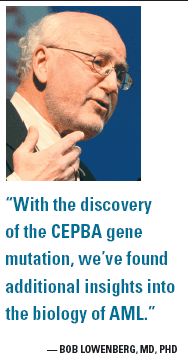Genetics opens new window on acute myeloid leukemia
SAN FRANCISCO-While genetics has opened up new possibilities for predicting treatment response in patients with acute myeloid leukemia, there are still unanswered questions about the relationship between genetic mutations and treatment outcome, according to Bob Lowenberg, MD, PhD, who delivered the Ham-Wasserman lecture at ASH 200
SAN FRANCISCO-While genetics has opened up new possibilities for predicting treatment response in patients with acute myeloid leukemia, there are still unanswered questions about the relationship between genetic mutations and treatment outcome, according to Bob Lowenberg, MD, PhD, who delivered the Ham-Wasserman lecture at ASH 2008.
In 1958, the year that ASH was founded, a study published in Blood posed the question of why some patients survive longer than others and noted that those who responded to chemotherapy had better survival odds.

“In 2008, we’re still dealing with variability in response and heterogeneity among AML patients when it comes to survival,” said Dr. Lowenberg, who is from Erasmus Medical University in Rotterdam, the Netherlands.
But a number of recent discoveries have made predicting treatment outcome much easier for patients who are likely to have a favorable response as well as those whose response is likely to be poor. Mutations in the CEPBA gene, for instance, have been shown to confer a significantly increased chance of remission and survival when compared with other genotypes. This gene is mutated in 5% to 10% of patients with AML.
“With the discovery of this mutation in one of the alleles or in both alleles on the chromosomes, we’ve found additional insights into the biology of AML,” Dr. Lowenberg said.
Other genotypes are now known to be less favorable. Patients with high expression of genes such as FLT3-ITD and EVI1 are more likely to have a poor response to treatment and an unfavorable prognosis. “With the discovery of these genotypes, we are beginning to understand the genetic basis of disease,” he said.
How can this gene-based knowledge best be used to deploy treatment? Dr. Lowenberg argued that patients with favorable genotypes are more likely to benefit from chemotherapy, where the rate of relapse is no more than 35% on average and the mortality is only 5%. But those with an unfavorable genotype and a risk of relapse of 70% or more may need a more powerful therapy, such as allogeneic stem cell transplant, which may reduce the relapse risk by 50%.
While genetics contributes to the improved treatment of AML, gaps remain in our understanding. The genotypes of patients with highly favorable or very poor outcomes are better understood than ever before, but the genetics of intermediate-risk patients has still not been fully explored, Dr. Lowenberg said. “It’s critical to understand the benefits and risk of transplant for these patients and to make an assessment of what the outcomes are likely to be,” he added.
Yet genetics continues to stride forward. Scientists have sequenced the entire genome of the AML cell, and have found 10 mutations, 8 of which were previously unknown. “We are not far from the day when we can develop treatments according to genotype. We are on our way to truly personalized therapy,” Dr. Lowenberg said.
Newsletter
Stay up to date on recent advances in the multidisciplinary approach to cancer.